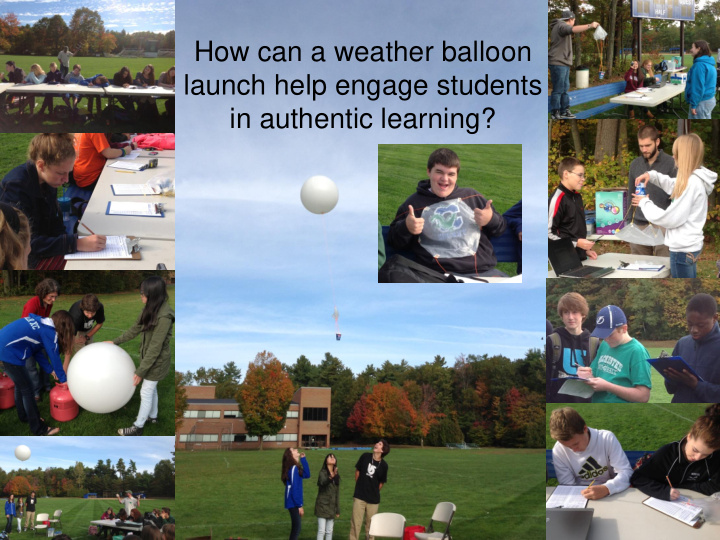



How can a weather balloon launch help engage students in authentic learning?
What is the atmosphere? How do we study it? Felix Baumgarnter’s stratospheric jump 1:30 summary montage https://www.youtube.com/watch?v=FHtvDA0W34I
How do we study conditions inthe atmosphere ? Animation to show POES v. GOES: http://spaceplace.nasa.gov/geo-orbits/ Weather Unpiloted NASA POES: polar-orbiting GOES: geostationary balloons weather drone Operational Environmental Satellite Operational Environmental Satellite Accessed on 9.30.13 from: Accessed on 9.30.13 from: Image accessed on 9.30.13 from: http://weatherlabs.planet-science.com/weather- http://www.automatedsciences.com/intro/intro.shtml http://4.bp.blogspot.com/_ddqtkOiADuo/TESByWXE06I/AAAAAAAAFA forecasts/where-do-forecasters-get-data.aspx U/GeCaNxjoifY/s1600/GOES- 13+is+America%E2%80%99s+New+GOES-EAST+Satellite.jpeg Weather observations Human free fall jumps Doppler RADAR Accessed on 9.30.13 from: Accessed on 9.30.13 from: http://www.extremetech.com/extreme/137867-the-best- http://www.southcoasttoday.com/apps/pbcs.dll/article?AID=/20070228/NEWS/702280 Image accessed on 9.30.13 from: photos-and-videos-of-felix-baumgartners-record-breaking-skydive 334&cid=sitesearch http://www.uvm.edu/~swac/?Page=photogallery.html
Goals • how atmospheric properties vary with altitude • how radiosondes and SWAC Sondes work • explore weather balloon launch data • logistics of a weather balloon launch • curriculum connections
What is the atmosphere? • envelope of gases surrounding a planet Graph image accessed on 3.16.2014 from: http://pattiisaacs.files.wordpress.com/2011/12/air-composition-pie-chart2.jpg Sky image accessed on 3.16.2014 from: http://climate.nasa.gov/system/news_items/main_images/blue_sky_clouds_538px.jpg
How is the atmosphere structured? Image accessed on 3.13.14 from: Image accessed on 3.13.14 from: http://ete.cet.edu/gcc/style/images/uploads/student%20pages/earth- http://media.web.britannica.com/eb-media/56/97256- atmosphere-layers.jpg 004-E3540AD9.jpg
What is a Radiosonde? radio – sends a radio signal sonde – device to collect physical data • Balloon carries meteorological instruments aloft • Temperature, moisture , pressure , and wind measured at many levels • Provides snapshot of these variables in the vertical • This information allows meteorologists to diagnose the atmosphere in the vertical
Why are these measurements important? • These observations allow us to diagnose the atmosphere similar to the snapshot that blood pressure measurements provide the doctor • When coupled with surface weather reports and satellite data, we get a 3 dimensional view (horizontal, vertical and time) of atmosphere • These measurements provide clues assisting the meteorologist in understanding and anticipating motion in the atmosphere
What does a vertical plot look like? • Temperature and Dewpoint (moisture) are plotted at appropriate pressure levels • Temperature values are connected with RED line • Dewpoint values are connected with GREEN line. • The closer together the temperature and dew point, the more moist the air is. • Where the lines are close, clouds are likely
Note relationship between temperature and altitude • Temperature decreases CricketSonde Temperature with altitude in lower 35 portion of atmosphere 30 (Troposphere) Altitude (km) 25 20 • Temperature increases 15 with altitude in upper 10 5 portion of atmosphere 0 (Stratosphere) -70 -60 -50 -40 -30 -20 -10 0 10 20 30 Temperature (ºC)
NWS Radiosonde System • Atmospheric Measurements • Temperature, Pressure, Humidity, Wind (indirectly) • Air-borne Payload System - $250 • Weather balloon, Helium, Parachute, Radiosonde (403 MHz or 1.6 GHz) • Ground Receiving Station - >$2000 (without computer) • 5-Element Yagi antenna and tripod, UHF radio receiver and modem, Computer and data collection software • Advantages • Robust data , Automatic data collection, Stratosphere and troposphere measurements (30 km altitude) • Disadvantages • High system cost , Apparently available only for government and research use , Encoded data requires expensive computer software to decipher
UVM SWAC Sonde • Air-borne Payload System: - $100 • Party balloon (Helium-filled), Model rocket parachute, UVM CricketSonde (434 MHz) housed in simple enclosure • Ground Receiving Station - $230 • 3-Element Yagi Antenna, UHF Radio Receiver, Pen and Paper • Advantages • Simple data collection method provides, real-time results, Launch most any place or time, Low system cost, Troposphere measurements (up to 10 km using party balloon), Stratosphere measurements (up to 30 km using weather balloon) • Disadvantages • May require technician-class amateur (Ham) radio license to operate
SWAC Sonde
How does a SWAC Sonde communicate temperature?
CricketSonde practice Conditions Sample # Pressure (mb) Temperature (K) Humidity (%) ___ ___ ___ ___ ___ ___ ___ ___ ___
Flight data (condensed) practice Sample # Altitude Pressure (mb) Temperature (K) (km) ___ ___ ___ ___ ___ ___ ___ 1 0.110 1000 2 9 8 2 1.0 900 2 9 __ 3 3.0 700 2 __ __ 4 4.2 600 __ __ __ 5 5.6 500 __ __ __ 6 9.1 300 __ __ __ 7 10.4 250 __ __ __ 8 11.8 200 __ __ __ 9 __ __. __ 150 __ __ __ 10 __ __. __ 100 __ __ __
Temperature (K) vs. Altitude (km) 20 Stratosphere 15 Altitude (km) Tropopause 10 Troposphere 5 0 200 210 220 230 240 250 260 270 280 290 300 Temperature (K) Temperature (K) vs. Altitude (km) To convert pressure to altitude, 20 students can interpolate using the graph above or they can use 15 an online calculator such as the Altitude (km) one on NOAA: 10 http://www.srh.noaa.gov/epz/?n =wxcalc_pressurealtitude 5 0 200 210 220 230 240 250 260 270 280 290 300 Temperature (K)
Data exploration • Using data from today’s forecasted sounding, you will: In Excel : 1. Graph sounding (temperature and altitude) data 2 Determine the altitude of the bottom of the tropopause 3. Calculate ascent rate Measure the circumference of a party balloon Measure the mass of the payload 4. Calculate flight time to reach tropopause In Google Earth: 5. Map where the balloon would travel if launched today from UVM and your school
Discussion of data exploration • Where would your balloon end up?
Curriculum connections
Colchester H.S. example • Studied structure, function, composition of atmosphere • Design challenge (payload, parachute, & “if found” letter) • Data collection • Data analysis & communication through formal scientific poster
Questions and Closing Image accessed on 3.16.2014 from: http://www.nasa.gov/images/content/407252main_image_1529_946- 710.jpg
Recommend
More recommend